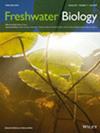Geographical and Habitat Factors Affecting Migratory Waterbirds Along Rivers in the Palearctic
IF 2.7
2区 生物学
Q2 ECOLOGY
引用次数: 0
Abstract
- Rivers are important habitats for many waterbird species, offering crucial resources such as feeding and resting areas during migration. The migratory patterns of these birds are influenced by a variety of factors, including geographical location, habitat availability and environmental conditions. Despite the huge ecological importance of rivers, there are few studies on how riverine environments support migratory bird populations across a broad geographical scale.
- This study aims to identify the key determinants of migratory bird distribution, species richness and abundance within river systems.
- The study was conducted during the autumn migration of birds in temperate zones of Europe and Asia. Through a combination of ecological assessments and statistical analyses, we identified the primary factors influencing migratory bird distribution, species richness and abundance.
- During migration along 14 large, unregulated rivers, we recorded 63,383 individual birds, representing 112 species. Analysis revealed significant associations between species richness and bird abundance and geographical proximity, with neighbouring rivers displaying greater similarity in species composition and density. The presence of sand banks and islands emerged as critical factors influencing species richness and bird abundance, while forested river segments negatively impacted species richness compared to open landscapes like agricultural areas. River width had no significant effect on avian assemblages.
- This study highlights the crucial role of habitat structures, particularly sand banks and islands, in supporting diverse waterbird populations. Our findings highlight the vulnerability of these habitats to anthropogenic alterations, which may adversely affect migratory waterbird numbers.
影响古北地区河流水鸟迁徙的地理和生境因素
河流是许多水鸟的重要栖息地,在迁徙过程中提供了觅食和休息等重要资源。这些鸟类的迁徙模式受到多种因素的影响,包括地理位置、栖息地的可用性和环境条件。尽管河流具有巨大的生态重要性,但关于河流环境如何在广泛的地理范围内支持候鸟种群的研究很少。本研究旨在确定河流系统中候鸟分布、物种丰富度和丰度的关键决定因素。这项研究是在欧洲和亚洲温带地区鸟类秋季迁徙期间进行的。通过生态评价与统计分析相结合,确定了影响候鸟分布、物种丰富度和丰度的主要因素。在沿着14条大型、不受管制的河流迁徙期间,我们记录了63,383只鸟,代表112个物种。分析表明,物种丰富度、鸟类丰度和地理邻近度之间存在显著相关性,相邻河流在物种组成和密度上表现出更大的相似性。沙洲和岛屿的存在是影响物种丰富度和鸟类丰度的关键因素,而与农业等开放景观相比,森林河段对物种丰富度产生了负面影响。河道宽度对鸟类群落的影响不显著。这项研究强调了栖息地结构,特别是沙洲和岛屿,在支持各种水鸟种群方面的关键作用。我们的研究结果强调了这些栖息地对人为改变的脆弱性,这可能会对迁徙的水鸟数量产生不利影响。
本文章由计算机程序翻译,如有差异,请以英文原文为准。
求助全文
约1分钟内获得全文
求助全文
来源期刊

Freshwater Biology
生物-海洋与淡水生物学
CiteScore
5.90
自引率
3.70%
发文量
162
审稿时长
2 months
期刊介绍:
Freshwater Biology publishes papers on all aspects of the ecology of inland waters, including rivers and lakes, ground waters, flood plains and other freshwater wetlands. We include studies of micro-organisms, algae, macrophytes, invertebrates, fish and other vertebrates, as well as those concerning whole systems and related physical and chemical aspects of the environment, provided that they have clear biological relevance.
Studies may focus at any level in the ecological hierarchy from physiological ecology and animal behaviour, through population dynamics and evolutionary genetics, to community interactions, biogeography and ecosystem functioning. They may also be at any scale: from microhabitat to landscape, and continental to global. Preference is given to research, whether meta-analytical, experimental, theoretical or descriptive, highlighting causal (ecological) mechanisms from which clearly stated hypotheses are derived. Manuscripts with an experimental or conceptual flavour are particularly welcome, as are those or which integrate laboratory and field work, and studies from less well researched areas of the world. Priority is given to submissions that are likely to interest a wide range of readers.
We encourage submission of papers well grounded in ecological theory that deal with issues related to the conservation and management of inland waters. Papers interpreting fundamental research in a way that makes clear its applied, strategic or socio-economic relevance are also welcome.
Review articles (FRESHWATER BIOLOGY REVIEWS) and discussion papers (OPINION) are also invited: these enable authors to publish high-quality material outside the constraints of standard research papers.
 求助内容:
求助内容: 应助结果提醒方式:
应助结果提醒方式:


